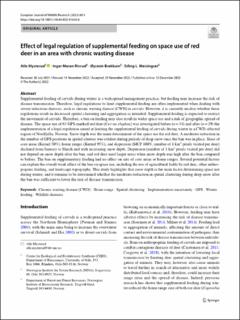| dc.contributor.author | Mysterud, Atle | |
| dc.contributor.author | Rivrud, Inger Maren | |
| dc.contributor.author | Brekkum, Øystein | |
| dc.contributor.author | Meisingset, Erling L. | |
| dc.date.accessioned | 2023-10-04T12:31:11Z | |
| dc.date.available | 2023-10-04T12:31:11Z | |
| dc.date.created | 2023-03-16T14:30:06Z | |
| dc.date.issued | 2022-12-12 | |
| dc.identifier.citation | Mysterud, A., Rivrud, I. M., Brekkum, Ø., & Meisingset, E. L. (2022). Effect of legal regulation of supplemental feeding on space use of red deer in an area with chronic wasting disease. European Journal of Wildlife Research, 69(1). | en_US |
| dc.identifier.issn | 1612-4642 | |
| dc.identifier.uri | https://hdl.handle.net/11250/3094153 | |
| dc.description.abstract | Supplemental feeding of cervids during winter is a widespread management practice, but feeding may increase the risk of disease transmission. Therefore, legal regulations to limit supplemental feeding are often implemented when dealing with severe infectious diseases, such as chronic wasting disease (CWD) in cervids. However, it is currently unclear whether these regulations result in decreased spatial clustering and aggregation as intended. Supplemental feeding is expected to restrict the movement of cervids. Therefore, a ban on feeding may also result in wider space use and a risk of geographic spread of disease. The space use of 63 GPS-marked red deer (Cervus elaphus) was investigated before (n = 34) and after (n = 29) the implementation of a legal regulation aimed at limiting the supplemental feeding of cervids during winter in a CWD-affected region of Nordfjella, Norway. Snow depth was the main determinant of the space use for red deer. A moderate reduction in the number of GPS positions in spatial clusters was evident during periods of deep snow once the ban was in place. Sizes of core areas (Kernel 50%), home ranges (Kernel 95%), and dispersion (MCP 100%, number of 1 km2 pixels visited per deer) declined from January to March and with increasing snow depth. Dispersion (number of 1 km2 pixels visited per deer) did not depend on snow depth after the ban, and red deer used larger areas when snow depth was high after the ban compared to before. The ban on supplementary feeding had no effect on size of core areas or home ranges. Several potential factors can explain the overall weak effect of the ban on space use, including the use of agricultural fields by red deer, other anthropogenic feeding, and landscape topography. This study highlights that snow depth is the main factor determining space use during winter, and it remains to be determined whether the moderate reduction in spatial clustering during deep snow after the ban was sufficient to lower the risk of disease transmission. | en_US |
| dc.language.iso | eng | en_US |
| dc.publisher | Springer Nature | en_US |
| dc.rights | Navngivelse 4.0 Internasjonal | * |
| dc.rights.uri | http://creativecommons.org/licenses/by/4.0/deed.no | * |
| dc.title | Effect of legal regulation of supplemental feeding on space use of red deer in an area with chronic wasting disease | en_US |
| dc.title.alternative | Effect of legal regulation of supplemental feeding on space use of red deer in an area with chronic wasting disease | en_US |
| dc.type | Peer reviewed | en_US |
| dc.type | Journal article | en_US |
| dc.description.version | publishedVersion | en_US |
| dc.rights.holder | © The Author(s) 2022 | en_US |
| dc.subject.nsi | VDP::Zoologiske og botaniske fag: 480 | en_US |
| dc.subject.nsi | VDP::Zoology and botany: 480 | en_US |
| dc.source.volume | 69 | en_US |
| dc.source.journal | European Journal of Wildlife Research | en_US |
| dc.identifier.doi | 10.1007/s10344-022-01630-6 | |
| dc.identifier.cristin | 2134502 | |
| dc.relation.project | Norges forskningsråd: 318575 | en_US |
| dc.source.articlenumber | 3 | en_US |
| cristin.ispublished | true | |
| cristin.fulltext | original | |
| cristin.qualitycode | 1 | |

